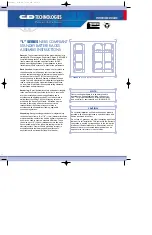
3. OPERATING PRINCIPLES
Page 23
© 2009 DH Instruments, a Fluke Company
are not allowed (see Sections 6.5.4, 3.2.8). In order to create
AutoRanged ranges or generate pressures above the SDS pressure
rating the RPM4 must be disconnected or the RPM4 SDS must be
upgraded to a higher pressure rating. Upgrades may be done at the DH
Instruments service center (see Table 36).
Position Identification of Q-RPTs In a PPC4 System
Position identification of the currently active Q-RPT or utility sensor in the PPC4 system is
continuously displayed in the upper right hand corner of the Basic Interface Main Run Screen
and most other screens. Position identification of the currently active Q-RPT or utility sensor is
displayed by selecting
[AutoRange]
and viewing the
RPT:
field in the Advanced Interface. See
Table 3
for position designation protocol for the Q-RPTs available in a PPC4 system.
See Table 1 for a complete listing of Q-RPTs available and their default ranges.
Table 3.
Position Designators of Q-RPTs in a PPC4 System
Q-RPT POSITION
IDENTIFICATION
DISPLAY SYMBOL*
Internal to PPC4, utility sensor, if present
Internal Utility, Hi
IuH
Internal to PPC4, Q-RPT of maximum
range
Internal Hi
IH
Internal to PPC4, Q-RPT with lower
maximum range in PPC4 with two
Q-RPTs or a utility sensor and Q-RPT.
Internal Lo
IL
External to PPC4, Q-RPT of higher
maximum range in RPM4, if present
External Hi
X1H
External to PPC4, Q-RPT with lower
maximum range in dual Q-RPT RPM4, if
present
External Lo
X1L
* The display symbol is included in the upper, right hand corner of most Basic Interface displays/menus and in
fields in AutoRange screens in the Advanced Interface.
3.2.6
Multiple Ranges (Q-RPTs, AutoRange and Infinite
Ranging)
A PPC4 range is defined as a pressure span and associated settings.
A PPC4 may have multiple ranges. Each Q-RPT (and the utility sensor, if present) available to the
PPC4 system has a default range which is its maximum span. Additional ranges, lower than the
Q-RPT’s maximum span, may be created using AutoRange (see Section 3.2.8). Ranges created
using AutoRange may be saved with all their settings for reactivation later (see Section 5.7.1 for
the Advanced Interface and Section 4.4.1.1 for the Basic Interface).
Most settings made in a PPC4 range, such as unit of measure, measurement mode, display
resolution, control mode and control parameters are specific to the range. Many settings
made while a range is active apply to that range and not other ranges. The range specific
settings are stored with the range and recalled whenever the range is made active. This makes
setting up and saving ranges a convenient way to store and recall frequently used operating
configurations. See Table 4 for a listing of PPC4 adjustments and settings and whether they are
range, Q-RPT or system specific.
The ranges available on a PPC4 system may be queried (Range) and/or created (AutoRange)
with functions available locally. External Q-RPTs connected to the PPC4 may be initialized
with RPT Search. For the Advanced interface see Sections 5.7.1. For the Basic Interface
see Sections 4.5.14, 4.5.10 and 4.5.12.
Содержание PPC4
Страница 70: ...PPC4 OPERATION AND MAINTENANCE MANUAL 2009 DH Instruments a Fluke Company Page 58 Notes...
Страница 194: ...PPC4 OPERATION AND MAINTENANCE MANUAL 2009 DH Instruments a Fluke Company Page 182 Notes...
Страница 226: ...PPC4 OPERATION AND MAINTENANCE MANUAL 2009 DH Instruments a Fluke Company Page 214 Notes...
















































